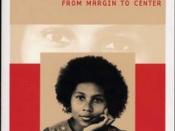In the article Adaptation: How Anger Turns Girls into Chameleons, the author Cheryl Van Daalen-Smith discusses the tendency for young women to bottle up a lot of their anger causing them to experience increased levels of stress, shame and depression and often internalizing the anger and directing it towards themselves. As a school nurse for 12 years, the author states that many young women were resulting to anti-depressants and anti-anxiety drugs in order to cope with their feelings instead of expressing them. She proceeds to connect girlsÃÂ anger to a societal tendency to silence, dismiss and deny the fact that females can and should have feelings of anger or aggression. She states that because of the societal pressures on females to be the ÃÂperfect girlÃÂ, women learn that they cannot get angry because it is un-ladylike and it creates isolation and criticism. This has caused many young women to turn to drugs, eating disorders and even self-mutilation.
She states that we need to veer away from associating anger with hostility and aggression and need to focus more on the reasons for girlsÃÂ anger. She describes how many girls try to resist the notions of femininity prescribed by society, but end up giving up and either in depression or living lives that they have adapted to fit the expectations put on them while leading a fake life. The article also describes how many girls fear loving significant others or ruining relationships if they express too many emotions of anger. They therefore end up bottling up those emotions in order to save their relationship. The issue in this article which demonstrates gender inequality is the effects that societyÃÂs expectations have put on women to suppress their anger. This demonstrates gender inequality because men are taught that anger and aggression are expected emotions for them, however women are taught that in order for them to fit into the description of the ÃÂperfect womenÃÂ they need to restrain from showing emotions of anger and aggression as it is not ladylike. Different feminist theories will view the issue of emotional suppression differently. In this essay, I will discuss how liberal feminist deconstruct the issue and what strategies they would use to tackle it. I will also discuss how diversity issues impact this specific problem as well as compare the views of radical feminism on the issue.
Liberal feminism is an individualistic form of feminist theory, which focuses on womenÃÂs ability to show and maintain their equality through their own actions and choices. Liberal feminism looks at the personal interactions of men and women as the starting ground from which to transform society into a more gender-equitable place. Therefore, Liberal Feminist theory would look at the issue of girlsÃÂ anger suppression in a way that would put the interactions of males and females within society as a reason of the anger to begin with. It would state that due to the notions of femininity that society has created, men expect women and girls to refrain from showing emotions of anger that are often associated with aggression and violence. Men often look for the ÃÂperfect girlÃÂ and the common idea is that female ÃÂperfectionÃÂ does not include anger or the hostility which is related to it. Girls are thus learning that because it is more difficult to change the way a patriarchal society views girlsÃÂ anger, it is easier to just adapt to the prescribed ideology of the proper emotions that they can express. This leads them to turn their anger inward, often resulting to depression, self blame and doubt or to put up a front and take on and adapted life that makes them seem like the girl that society expects. In order to solve this problem, liberal feminist strategy would state that a shift needs to happen in the way that women express their anger and that education is necessary for men in order for them to learn that a women can still be feminine even if she were to express emotions of anger. Furthermore, women need to see that their anger is a normal humanistic emotion and that expressing it does not make them hostile or aggressive. Women need to express their emotions regardless of what is expected and when that is done, then society will learn to accept it gradually. Finally, feminist theory would state that because it is acceptable for men to show emotions of anger, as aggression is expected from them, then in order to achieve equality between genders, we need to ensure that the same emotions are viewed as acceptable to women as well. Men need to learn to foster womenÃÂs emotions within relationships and that society and institutions need to start viewing anger as a form of expression rather than a way of oppression by expecting females to bottle it in. However, it is also key to realize that different women have different expectations and that not all women will be able to make these changes in the same way.
Diversity plays a major role in the lives of women and womenÃÂs issues. For many years, feminism categorized all women and their issues into one category and it was thought that all women had the same issues. However, today it is clear within the feminist movement that different women have different issues and needs. In the article, the author does not really differentiate between different womenÃÂs cultures and backgrounds. The author doesnÃÂt discuss how different traditions and cultures expect different things from girls. Although she does speak about the experiences of the 29 Caucasian women in one of the studies she references, she does not speak about the experiences of any girls from other cultural backgrounds. That is often seen within feminist theory. For example, Betty Friedan spoke of the reason upper class white women became frustrated in her book The Feminine Mystique. However, she did not speak about what frustrates populations of women of Asian, African, Arab and other cultures. Often women of color feel silenced by white women. They are also often silenced by the expectations that their cultures have on them (Agnew, 1996). Bell Hooks (1981) explains that while white women were standing up against the expectation of them being merely housewives and mothers, black women who have been working low class, hard labour jobs were longing to have the option of being merely housewives and mothers. Furthermore, it has been argued that the feminist movement has greatly ignored the intersection of race, class and gender and that little research was done on the needs of women of color in the beginning of the movement. Moreover, during the second wave of the feminist movement there was an unwillingness to talk about issues that women from racialized backgrounds were facing due to different cultural practices. For example, a womenÃÂs role in South Asian communities is to be devoted to her family and to focus on selflessness, deference and sacrifice (Agnew, 1996). This sacrifice of her own need for the sake of her family may cause a lot of frustration and anger in womenÃÂs lives. However, in the article Adaptation: How Anger Turns Girls into Chameleons, the author states that the 29 Caucasian women studied had ÃÂanger rooted in hurt, frustration, and disillusionment and was precipitated by unfair and/or disrespectful treatment or a lack of reciprocity in relationshipsÃÂ (Van Daalen-Smith, 2009). This shows that there is a difference between what may cause anger in different women, especially women of different cultural backgrounds. Even different feminist theories view womenÃÂs issues differently.
Radical feminism is a philosophy emphasizing the patriarchal roots of inequality between men and women, or, more specifically, social dominance of women by men. Radical feminism views patriarchy as dividing rights, privileges and power primarily by gender, and as a result oppressing women and privileging men. Radical feminism states that the oppression of women is universal. This theory would view womenÃÂs anger suppression as a form of social domination that men practice in order to control women. Radical feminists would state that by making it unacceptable for women to express anger, by associating it with hostility and violence, men can ensure that women do not speak up against the causes of anger in fear that they will be shunned. This allows men to continue with their oppression without having to struggle against women standing up against them. Moreover, some radical feminists would view the notion that women need to suppress their anger in order to save relationships and avoid losing significant others by suggesting that women enter into relationships with other women instead of men. That way they can express and share similar emotions because they can relate to each other.
In conclusion, there are several reasons why women suppress their anger. Sometimes it is to save relationships and significant others, but most often it is because they have been taught that anger is a form of hostility and aggression, characteristics that are not acceptable in societyÃÂs notion of the ÃÂperfect womenÃÂ. Moreover, men are often taught to look for the ÃÂperfect womenÃÂ and in order to find a partner, women have to conform to that expectation. Often that is by bottling up their anger or directing it inwards causing depression, shame and self loathing. Many women are resulting to anti depressants and drugs in order to deal with their emotions. However, it is also important to realize that different women experience and express anger differently and that different cultures have different expectations of women and their emotional expression.
ReferencesAgnew, V. 1996. Resisting Discrimination: Women from Asia, Africa and theCaribbean and the Women's Movement in Canada, University of Toronto Press, 1996.
pp. 72-92, 224-230.
bell hooks. 1981. AinÃÂt I a Woman: black women and feminism,.Gloria Hawkins, SouthEnd Press, Boston. 1981, pp. 181-196Van Daalen-Smith. 2009. Adaptation: How Anger Turns Girls into Chameleons. Herizons,Spring 2009, pp. 33-35





